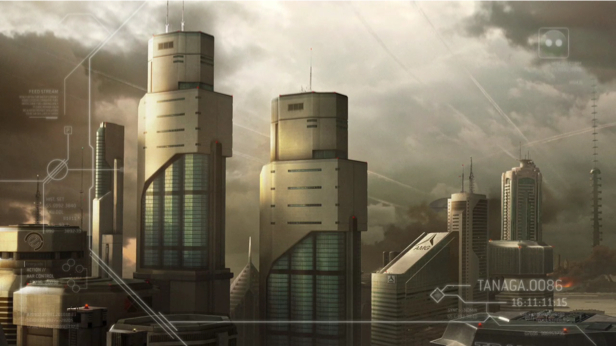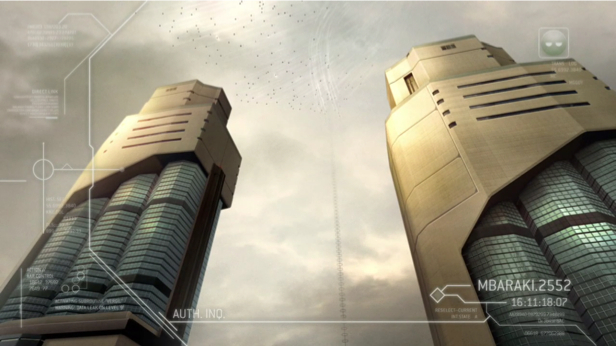Into the Ashen Wake (Part One)
The teaser begins on the coastline of a large metropolitan city.
Here we see dark, smoke-drawn clouds being penetrated by hazy beams of sunlight. The robust skyline of ivory towers and industrial plants already speaks to the game’s relationship with the Halo trilogy. One building reads “Traxus,” a company which plays a large artistic role in a Halo 3 mission entitled “The Storm.” That level follows the Master Chief through a Traxus warehouse on the coast of Voi, as he makes his way to a Forerunner artifact – the gateway portal which leads both the Covenant and humanity to the ancient cradle world we all know as the Ark.
Although the foreground of this first shot is what might initially catch one’s eye, the real story lies in its background. In the distance, beyond what appears to be a large body of water, we see another extension of this metropolis – a large city at the base of a space tether. The city here is in flames, clearly the result of some unseen force. Large plumes of smoke billow into the air, devouring the orange glow of afternoon sunlight, painting a bleak scene for the inhabitants of the city.
The next sequence shows what, for the uninitiated, might appear to be a meteor of some sort. In actuality, it is a Human Entry Vehicle, or HEV. This is essentially a drop pod for a very specific class of UNSC paratroopers, a class you might remember from the Halo novels, as well as from the cinematic before Halo 2’s “Delta Halo” mission. This deployment container is used by the ODST or Orbital Drop Shock Troopers. In the Corps, they’re called Helljumpers for short, as their job description makes their duties brutally clear: “Jumping feet first into hell.”
Here, we see a slew of HEVs falling into the azure atmosphere of a planet, their outer-armor engulfed in fire by the compression of air against their heat shields. Given that the ODST squads are only deployed in the most dire of circumstances, it would seem that there might be something critically important about the cityscape that we just saw. The serene, but haunting shot of a coastal metropolis conveys that these ODST units are dropping into a war zone.
Or at least the ashen wake of one.
Then we return to that same shot – only this time there are a series of heads-up display graphics, text and the hollowed out image of the Superintendent in the background. It is here that things begin to come together. In the preceding days to this trailer’s release, a pair of Bungie.net updates covered two specific communications amongst a variety of entities – adding to the fiction of this Superintendent character, while simultaneously and inexorably tying him to the Halo universe.
The first update, which was released on September 19, 2008, and entitled “Keep It Clean,” follows the communication between an urban infrastructure A.I. and a comm duty officer aboard the Prowler-class vessel, Tokyo Rules. The message is entitled and coded as being from the Office of Naval Intelligence, better known as ONI. This particular group, if you’re not readily familiar, operates largely in a clandestine fashion and with deep layers of secrecy, much like our existing real world intelligence agencies.
The content of the first transmission is a series of random and sporadic statements uttered by a maligned A.I., our very Superintendent and the one in which we’ve followed for months now. Here, he acts no differently than he has before: spilling warning after warning despite the other party’s attempt to ignore or intervene. Now revealed to be the custodial A.I. construct of a city, the Superintendent is communicating with an officer aboard Tokyo Rules about a city emergency within his jurisdiction. Tokyo’s communication officer advises that they are sending personnel and requests of the construct to put “Kinsler” on the line.
Soon thereafter, we see that the Superintendent is not functioning as he should, constantly interrupting the agent until the inconsistency is addressed verbally by the officer himself. He states that he wants to see a log of the A.I.’s last 24 hours, being that there appears to have been a “core data corruption” with at some point. What does that mean? The A.I. construct has been severely damaged.
And he likely culprit? The Superintendent’s metropolitan emergency, no doubt.
In the second transmission, “Pardon Our Dust,” an agent codenamed DARE.V.500.41(S1) gives us our first clue: Section One (S1) is a division of ONI which is tasked with military reconnaissance -more specifically, with gathering communications from enemies for tactical use against them. In the case of the Halo trilogy, Section One dealt largely with communications amongst Covenant ships. The most proficient vessel for such recon is typically that of the Prowler class, coming full circle and building context for the level of urgency that this message bears.
Both of these transmissions set the stage for the teaser that was released.
Returning back to the teaser, we now know that we are seeing through the eyes of the Superintendent and, despite the hint of war in the far background, everything is initially functioning as it should.
The shot is now revealed to be Tanaga.0086 at 16:11 PM, a specific time and location within this city – this camera, #0086, is likely a monitoring mechanism of the Superintendent for the district of Tanaga. Keen observers have also noticed the darkened visage of a Covenant assault carrier which looms in the distance, moving behind the skyscrapers near the heart of the city and its space tether. Although the teaser offers nothing more about it at this time, later we discover whose vessel it is and what it was doing.
The second shot is of a darkened, low-level city street reeling from some sort of attack. Here, we are offered just a bit more information. The futuristic vehicles and street side palm trees you may have already associated with the African coastal city of New Mombasa from Halo 2, but that association becomes entirely concrete with the flashing evacuation warning on the left which reads: “City Of New Mombasa.”
Here we find the district of Lumumba, and it appears as though there has been an incredibly large amount of damage sustained. The darkness from the ash is so thick that it looks more like midnight than four o’clock in the afternoon. This location might be at the base of tether, as hinted at from the Tanaga shot.
It is worth pointing out here that for a brief moment you can see some interesting text in the bottom right-hand corner of the above screenshot. It appears as though the Superintendent is aware of, and possibly tracking, the Master Chief’s location. Much like the tracking of his arrival back into the system after the events of Halo 2 (chronicled in the “Landfall” video), his Mjolnir armor likely allows the UNSC to track his location when he is in range of the necessary equipment – and, whenever he is located within a city (especially during wartime), it would make sense for the custodial A.I. to have access to this information.
The next sequence is where the trailer really takes off, connecting the dots between the previous sequences.
Here, we at first simply see two massive skyscrapers rising upward into the air, and a giant space tether (which we can assume is the same from Halo 2, since we now know this city is New Mombasa) disappearing into the clouds. This is Mbaraki, an actual location in the real world Kenya, further interweaving reality with Halo’s fiction. What we are looking at is the city’s center, the same location in which the Master Chief was able to destroy the Scarab during Halo 2’s “Metropolis” mission.
As the camera rises, the Superintendent is monitoring what has become a ghost land; it spots a slew of incoming contacts dropping in from above the atmosphere. Although several dozen appear to travel off to the left of the screen, at least sixteen swing downward.
They are the source of the construct’s attention and he clearly examines them closer.
When this happens and the shot shifts to the previous Tanaga camera, a massive bloom of energy off to the left begins to shake the camera, jarring the graphical user interface of the construct’s monitoring system. The “explosion” of sorts is not dissimilar to another one we’ve already seen: Halo 2’s slipspace event. Shortly after the Chief eliminates the threat of the Scarab, Commander Miranda Keyes follows the Prophet of Regret with her own frigate, pushing through the same slipspace rupture that the Covenant leader broke open while just above the city of New Mombasa.






